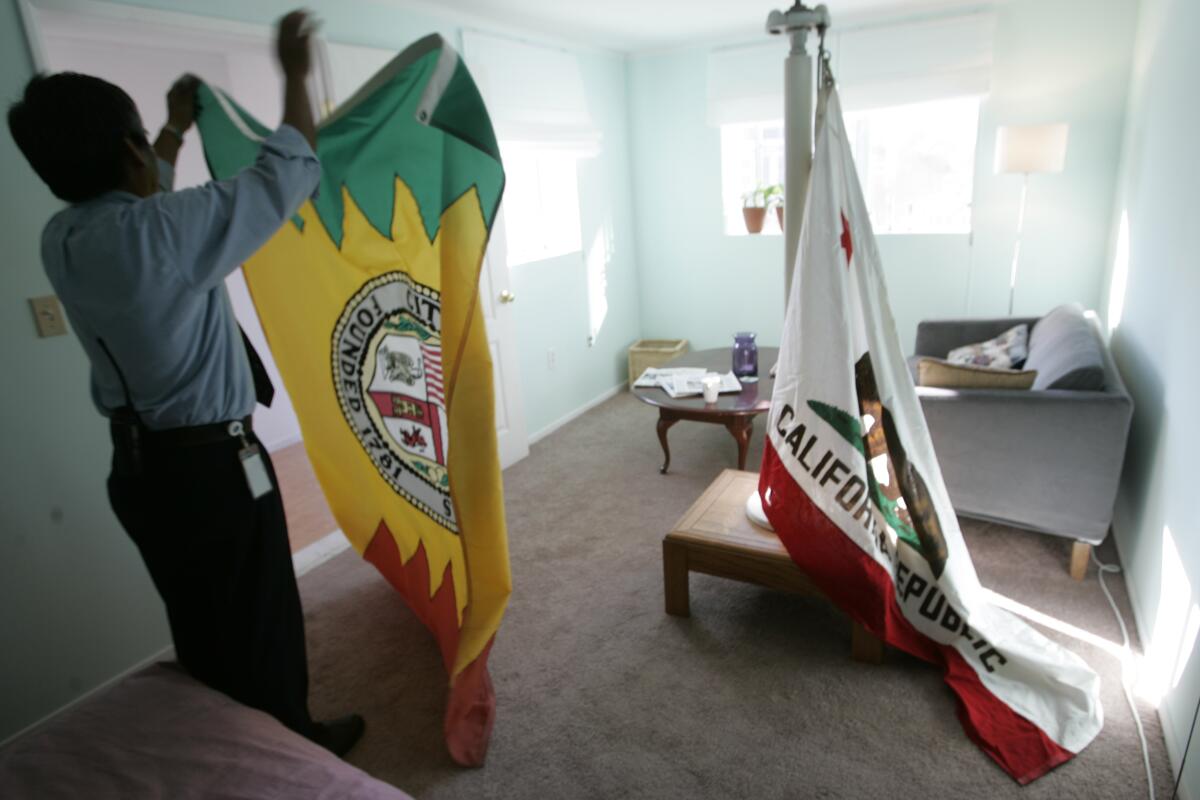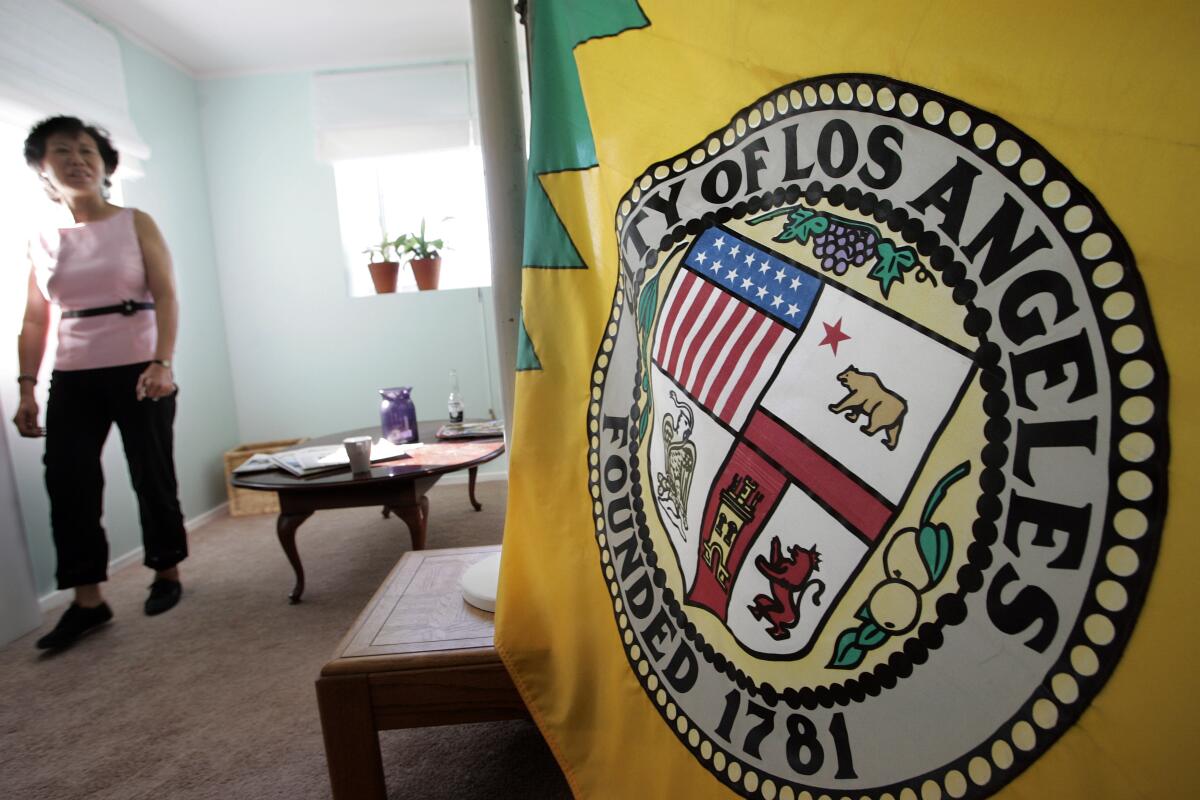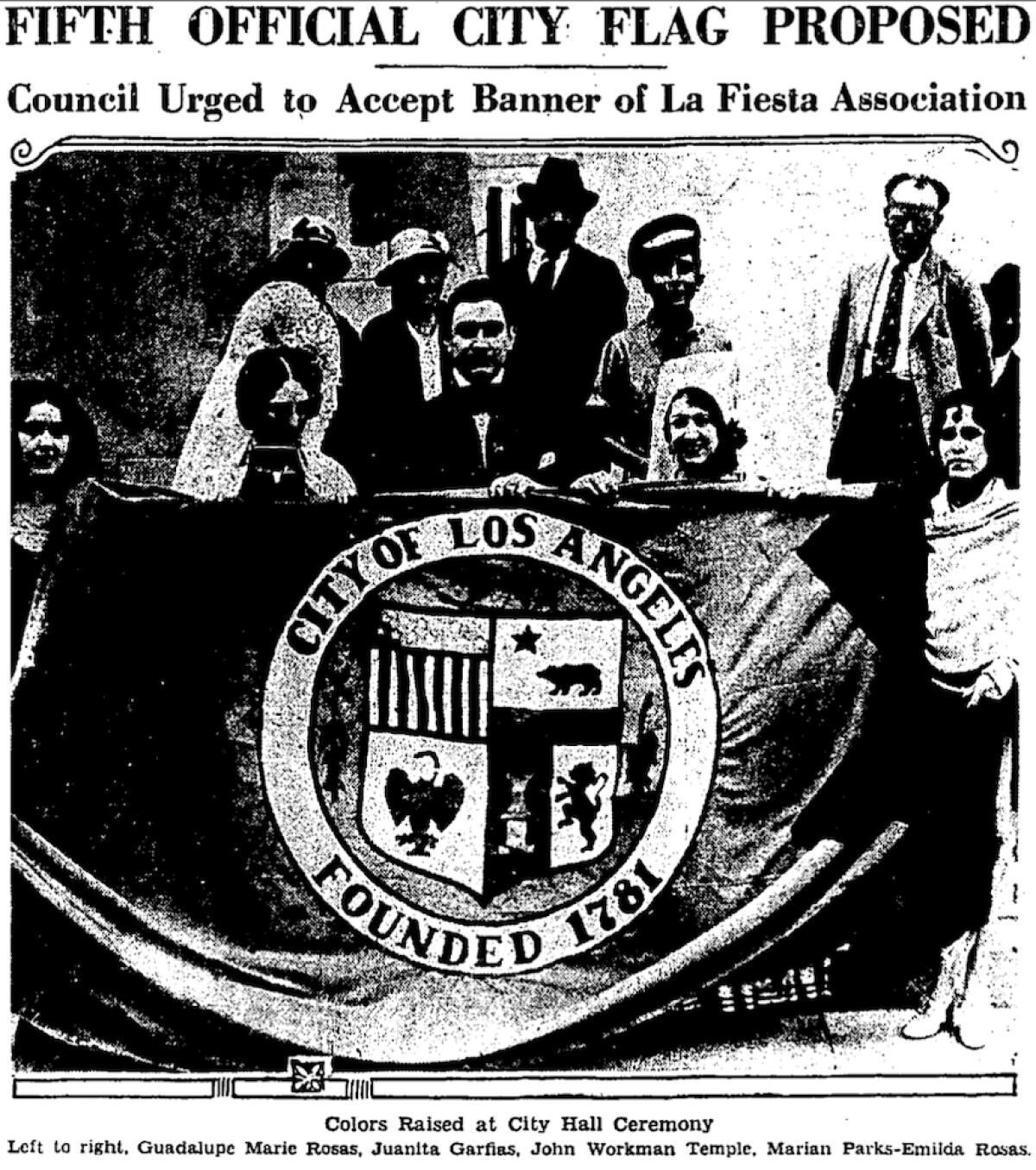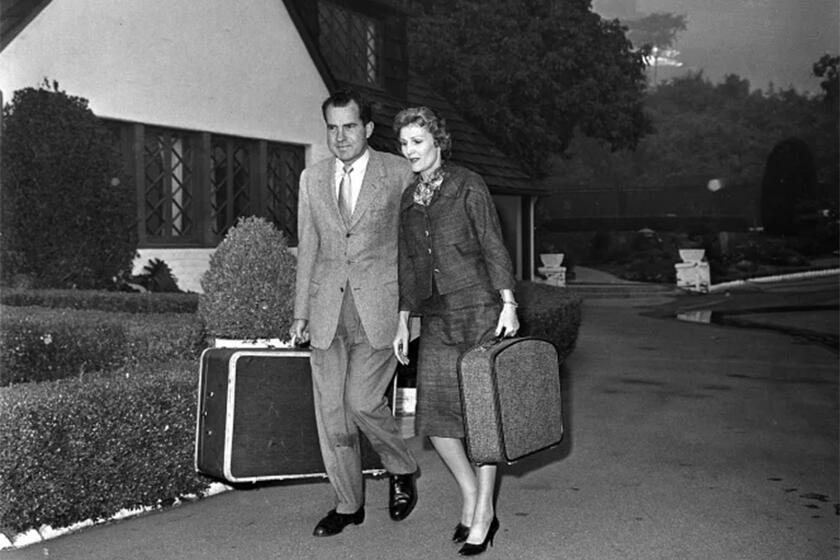The story of L.A.’s oddball flag. Wait, L.A. has a flag?

You’ve probably seen it without even registering what you were seeing.
A flag of three vertical bands of color with sawtooth borders between, and some round fancy thing in the middle that’s indecipherable when you’re standing on the ground and the flag is flapping away 20 or 30 feet in the air.
Among the three flags that were likely on that flagpole, this one was on the bottom. The top one, you’d recognize: Old Glory, inspired by the original revolutionary banner mythically miscredited to Betsy Ross but in fact the likely work of a very artistic New Jersey congressman.
And below that, the California flag, a neatened-up version of the original Bear Flag of the Republic of California, which lasted a monumental 25 days, in 1846. It was daubed in red-brown paint on a length of unbleached cotton, with a single star and what was supposed to be a bear but looked in all honesty so much like a pig that when native Californians saw the cloth afloat atop a makeshift flagpole, they passed among themselves the word “coche” — pig. A porcine resemblance may not be startling, considering that a number of the Yankees who “declared” their makeshift republic were, by early historians’ accounts, drunk and giddy yahoos. The original pig-bear flag burned up in the fires of the 1906 San Francisco earthquake.
But that flag on the bottom, in green, yellow — OK, gold — and red, with the zigzags and busy round thing in the center: That’s the official flag of Los Angeles, with the city seal at its center. All hail!
You can bet that the Dodgers’ flag rates a lot higher on the flag-recognition scale than the L.A. city flag.
Explaining L.A. With Patt Morrison
Los Angeles is a complex place. In this weekly feature, Patt Morrison is explaining how it works, its history and its culture.
For sheer drama, one of the city flag’s splashiest moments didn’t happen in Los Angeles. It didn’t even happen in this country.
In Moscow, in August 1980, the Olympics ended with closing ceremonies of Games that had been boycotted by the United States because of the Soviet invasion of Afghanistan. Now, it is the custom at the end of each Olympics to fly the flags of Greece, where the ancient event began; of the hosting nation — in 1980, the Soviet Union; and of the nation that would be hosting the next Summer Games — the United States, in L.A., in 1984.
Except the Carter White House put its foot down: No U.S. flag would fly at the Moscow Games.
Yikes! In an account from the International Society of Olympic Historians, the International Olympic Committee director, Monique Berlioux, told the man who would run the L.A. Olympics, Peter Ueberroth, that she had discovered a possible loophole: The English and French versions of the flag rule were different. One — she doesn’t say which — commanded the raising of the flag of the organizing city; the other, the flag of the country of the organizing city. So there was the “out,” and they took it.
And — just like in the movies — the stand-in became the star. The flag of the city of Los Angeles would fly alongside Greece’s blue and white and the Soviet Union’s hammer and sickle at the closing ceremonies.

But where in Moscow to get an L.A. city flag? Ueberroth called Mayor Tom Bradley, who hurried a flag off to Moscow by airline courier. The outgoing IOC president, as The Times reported, rather absurdly assured everyone that if it didn’t get there in time, why, the Bolshoi Theater could run up a copy in half an hour. A Commie L.A. flag? Heavens to Betsy Ross! Thankfully, the flag arrived from L.A. on a Thursday evening, well ahead of the Sunday ceremonies.
And there, as The Times wrote, “about 100,000 puzzled sports fans watched an unfamiliar banner being raised where they had expected the Stars and Stripes.”
The rest of the city flag’s story, before and after, has been more earnest than dramatic.
For the longest time, the city didn’t seem to have a flag at all. But it certainly had a city seal, and one of the earliest — if not the earliest, in the 1880s — was a cluster of grapes inside a circle.
Then, in 1905, Herbert Goudge (or Goodge; The Times unhelpfully spelled it both ways), one of the city’s lawyers and a man born in England, where fancy heraldry has been a sine qua non for centuries, decided that that seal wasn’t good enough for his adopted city.
Los Angeles was California’s original Napa Valley, with myriad acres of vineyards planted by Italian and French growers and experts, and wineries all along the Los Angeles River. There’s a boastful song from 1876, five rum-te-tum verses of “The Wines of Los Angeles County.”
But by 1905, Goodge believed, “a cluster of grapes was not an adequate seal, I thought, for a dignified city, such as Los Angeles had become. So I told the city council my objection. … All right, Georgie, said the councilmen. Then you go ahead and make a new city seal.”
Man, those were the days, right? No committees, no contests, no contracts — just some noodge on the city payroll speaks up, and his buddies say, go for it!
And that’s what we have to this day — a quartered circle with “the four epochs of the city’s history,” as The Times described it:
- A United States banner.
- The eagle and snake symbol of Mexico.
- California’s Bear Flag.
- Spain’s royal lion and castle, for the kingdoms of Leon y Castilla.
Ornamenting this are a cluster of grapes, an olive branch and oranges of the city’s agricultural past, and encircling it all, a 77-bead rosary, signifying — so says the city’s website — the role played by Spanish missions in the city’s history. (The rosary is odd, because Los Angeles County fought itself and others in court for more than a dozen costly years over whether the county seal could keep the image of a mission topped by a cross, whether it was about history or religious exclusion — and finally, a federal judge’s decision meant the county had to ditch the cross, but it kept the mission.)

That’s the seal story. But how did the L.A. city flag come about?
As late as 1912, the city didn’t bother with a flag. Then a minister of the gospel suggested that the city should have its own banner. The mayor, George Alexander, owed his job to the newly enfranchised women voters of Los Angeles, so when members of women’s clubs mobbed City Hall to protest that Old Glory was glorious enough for any city, the mayor wasted not a moment to declare, “The American flag is good enough for me. … I am not at all in sympathy with the idea of adopting a municipal flag.”
And there matters stayed for almost 20 years.
In 1931, for the city’s 150th anniversary, the want of a flag came up once more. La Fiesta Assn., a powerful business- and tourism-promoting organization that had been staging “Spanish”-themed parades and PR events in town since the late 19th century, evidently held a contest.
The winning design was the handiwork of an oil engineer with the marquee-worthy name of Roy Silent and E.S. Jones of the Jones Decorating Co.

This “Fiesta Flag” that the organization presented to the city was pretty simple. It put the city seal at the center, over three vertical bands of color, described as the green of olive trees, the yellow of oranges — lately described as “gold,” which makes more sense, because oranges are, well, orange, not yellow, and gold is more resonant — and the red of vineyard grapes. More diplomatically, the city now ascribes the colors to the flags of Mexico and Spain.
Soon thereafter, the “fiesta flag” became the city’s official flag, under city ordinance No. 70,000. The flag was officially hoisted at City Hall in April 1937 by Mayor Frank Shaw, who just over a year later became the first big-city mayor to be recalled from office. Don’t blame the flag.
Here is where I have to look farther afield, to the flagpoles of New York and San Francisco.
New York, as always, goes overboard on the self-regard. It has a city flag, a mayor’s flag, a City Council flag, flags for several of its boroughs, for its departments of parks and recreation and sanitation.
The city flag has vertical bands of blue, white and orange — orange from the early days as the Dutch city of New Amsterdam — and a version of the city seal. On it, a bald eagle hovers over the figures of a seaman and a Native American (Los Angeles’ seal doesn’t acknowledge its native forebears). Between them is a stylized windmill, wooden barrels — for the city’s early flour milling industry — and a beaver, for the early trade in beaver fur.
The German immigrant John Jacob Astor, whose surname became a synonym for the hoity-toitiest New York society, started his fortune by cleaning, buying and selling fur pelts. His manners — eating peas with a knife and once wiping his fingers on the sleeve of his hostess’ dress at dinner — would have mortified his fastidious descendants but did not stop him from amassing a real estate fortune that was eventually worth almost 1% of the national GDP.
As for the words on the ribbon at the bottom of the seal — well, that’s just showing off. They’re Latin, and all they mean is: “Seal of the City of New York.”
Where do Santa Ana winds come from and how did they get their name? And how does the O.C. city of Santa Ana feel about it?
Of the three, San Francisco’s flag, created in 1900 and officially adopted in 1940, is the least cluttered. It’s a streamlined version of the city seal. A phoenix — the mythical bird that rises from its own ashes — hovers over crimson flames, just as San Francisco was built and burned and built again many times, even before the 1906 earthquake.
And the motto — in Spanish, again something L.A. didn’t bother with — is pretty bellicose, from the age of the Spanish-American war: “Oro en Paz. Fierro en Guerra” — gold in peacetime, iron in wartime.
A writer in the San Francisco Examiner argued a half-dozen years ago for a new city flag: “The ‘flames’ look more like a crappy red crown drawn by an sixth grader, and the phoenix looks more smug than defiant.”
If we’re going to start redesigning flags, L.A. should get at the front of the line. How about some native American acknowledgement? And rosary beads? Really?
The flag’s current colors don’t say “L.A.” at all. Where’s the blue for the Pacific, a true orange for oranges or the brown for smog, if you want to be smart-assy about it? A ribbon of film, instead of a ribbon of Latin?
As for the state flag, it doesn’t bear repeating on ours. (The godawful fate of Monarch, the captive bear who was the model for the modern state flag, is a tale of humans at their worst. Within less than 200 years, we managed by torture, bounties, caprice and cussedness to wipe out every last California grizzly.)
So let’s have something old, something new, something borrowed, something blue.
Old? L.A. is nearly 250, a quarter-millennium. Old enough for you?
Borrowed? The striking and dramatic bird of paradise, the official city flower, like so much of our local flora, is imported — borrowed — from elsewhere; in this case, South Africa.
As for something new, we are desperately in need of a new city motto. We tried out the dreary “L.A.’s the Place.” In 1995, in the home of Hollywood, the city managed to come up with only “Together we’re the best. Los Angeles,” which is very “Kumbaya” but also insecure and defeatist. Then it was “That’s So L.A.,” an eye-roll punchline to an L.A. joke.
Be bold. Be brief. Be inspired, for example, by what’s chiseled on the legendary food writer Jonathan Gold’s gravestone: “Tacos Forever.” Who wouldn’t salute that?
Should California be split into two states? Three? Six? At the very least, we’re due for another round of intrigue on an eternal question about the Golden State.














